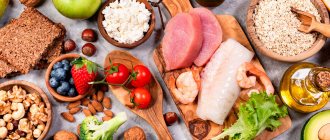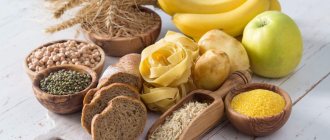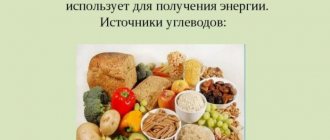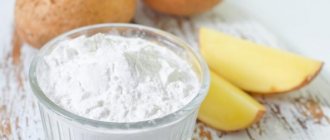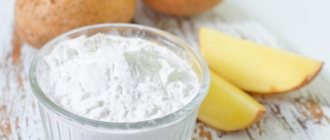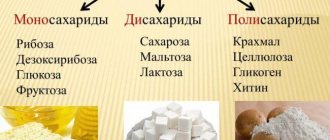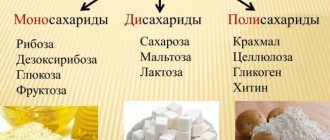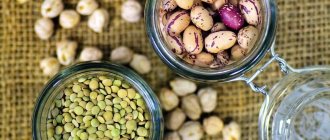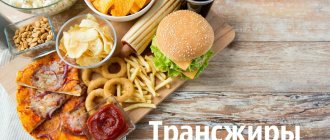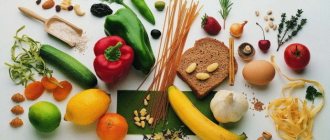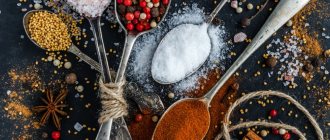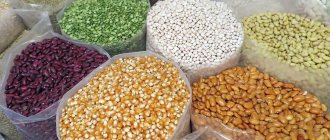Carbohydrates are natural organic substances. Their formula contains carbon and water. Thanks to these elements, the body draws the energy it needs to maintain normal functioning. Depending on their chemical structure, carbohydrates can be simple or complex.
What are carbohydrates
Carbohydrates are the main ingredient in most foods and serve as a source of energy for the human body. Depending on the number of structural units, carbohydrates are simple and complex.
The first category is also called fast carbohydrates. They are easily digestible and lead to a rapid increase in blood sugar. This means that the substances have a high glycemic index.
Such elements provoke metabolic disorders and cause weight gain. Systematic consumption of foods containing simple carbohydrates not only leads to obesity, but also causes many other diseases.
Complex carbohydrates, which include starch and fiber, contain many linked saccharides. They contain a large number of structural elements. Food with such carbohydrates is considered very healthy. During the digestion process, it gradually saturates the body with energy. This gives a long-lasting feeling of fullness.
Laboratory diagnostics of carbohydrate metabolism
Previously, before the advent of modern research methods, doctors were faced with a not particularly noble job: they had to taste urine - and in diabetics it was sweet. Now the task has become somewhat simpler - so, what laboratory indicators are worth paying attention to:
- Triglycerides > 1.7 mmol/l.
An increase in the level of insulin in the blood stimulates lipogenesis - this, by the way, plays an important role in the pathogenesis of acne development: the higher the level of triglycerides, the more sebum is secreted.
- Fasting insulin >5-6 mmol/l.
- NOMA index > 1.3.
- Fasting glucose >5.5 mmol/l.
Optimum: 3.5-5.5 mmol/l.
- Glucose on oral glucose tolerance test >11 mmol/L.
Optimum: <6.9 mmol/L (6.9-11 mmol/L indicates prediabetes).
- Glycated hemoglobin - reflects the average blood sugar content over 3-4 months (lifespan of red blood cells) > 6.5%.
Optimum: up to 5.2%.
- C-peptide is a molecule that is cleaved by protein enzymes from the precursor of insulin and is thus an indicator of its secretion.
Reference: 1.4-4.4 ng/l.
Optimum: middle of reference values.
- LDL (low-density lipoprotein, atherogenic) > 3 mmol/l.
- HDL (high density lipoprotein, antiatherogenic) < 1 mmol/l in men and < 1.2 mmol/l in women.
Glycemic index
(GI) is an indicator of exactly how the carbohydrates consumed affect changes in glucose levels.
As previously mentioned, a feature of simple sugars is their ability to sharply increase the glucose level in the serum - this effect does not distinguish them favorably from complex carbohydrates.
We recommend
“Complex carbohydrates for weight loss, muscle gain and diabetics” Read more
The body's reaction is immediate: a powerful release of insulin occurs in the pancreas - a hormone designed in this case to neutralize excess glucose in the blood, but then follows the same uneven sharp decline. Hence the need to focus on foods with a low glycemic index that do not cause such “swings” in glucose concentrations:
- Chickpeas
- Beans
- Plums
- Pomegranate
- Cherry
- Raspberries
- Currant
- Mushrooms
- Broccoli
- Asparagus
- Fennel
- Lentils
- Avocado
- Olives
- Seaweed
- Cauliflower
- cucumbers
- Leafy vegetables
However, another indicator is no less important - the insulin index.
. It displays the amount of insulin secreted in response to the intake of a specific food.
Very often, foods with a low glycemic index, while having a high insulin index, cause many adverse effects. Such foods include dairy products.
Amino acids with branched side chains contained in milk are powerful stimulators of the synthesis and subsequent release of insulin (the AI of cottage cheese is approximately 100-120). This is a paradoxical situation at first glance: cottage cheese does not cause a sharp jump in glucose (GI = 30 and is quite low), but it leads to a significant secretion of insulin, to the calls of which the cells are already deaf.
The pancreas compensatory begins to produce more and more insulin in order to somehow break through the insurmountable wall - this eventually leads to its depletion. The patient is forced to receive it from the outside - in the form of injections.
Functions of carbohydrates in the body
The key function of carbohydrates in the body lies in their transformation into energy. ATP, which is a universal source of energy, contains the monosaccharide ribose. ATP is formed due to glycolysis. This process involves the oxidation and breakdown of glucose into pyruvic acid.
Glycolysis occurs in several stages. Carbohydrates are oxidized to water and carbon dioxide. This process is accompanied by the release of energy.
The main functions of carbohydrates include the following:
- Structural.
Polysaccharides are the material for supporting elements. Cellulose, which is part of the structure of cell walls, gives plants rigidity. Fungal cells contain chitin. - Energy.
Carbohydrates represent the main source of energy. The breakdown of 1 g of carbohydrates releases 17.6 kJ of energy. - Protective.
The thorns and thorns of plants are made up of these elements. - Storage.
Carbohydrates are stored in the form of starch in the structure of plants and glycogen in animals. When there is a lack of energy, these substances are broken down into glucose. - Osmotic.
Substances help regulate osmotic pressure. - Receptor.
The elements are present in the composition of cellular receptors.
Individual carbohydrates form complex structures with protein elements and lipids. As a result, glycoproteins and glycolipids are formed. These elements are present in the composition of cell membranes.
Isomalto-oligosaccharides (IMOs) : real fiber?
Read also: Osteoporosis. Bonvivia and other bisphosphonates
In most cases, if you happen to pick up a bag of low-carb food off the grocery store shelf and look at the label, you will see in the overall nutrient profile that it contains about 20 grams of carbohydrates, but maybe 15 of those grams are classified as “fiber.” " That results in five grams of net carbs, right? Not so fast. If a type I diabetic eats that bar, cookie, or brownie with five grams of net carbohydrates, then there should be no need for insulin, since theoretically the minimum amount of glucose entering the system from those five grams of net carbohydrates is the amount of carbohydrate that should not cause an insulin response .
Unfortunately, theory and results in practice do not always coincide. IMO can be made in several ways, but they are primarily derived from a sugar called maltose. IMO is promoted as a prebiotic, dietary fiber with a mild sweet taste. Its functional properties (i.e. moisture retention, low viscosity) make it suitable for bars, cookies, candies and the like. To fully understand IMOs and how the body processes them, we first need to understand how starches are digested in the body. Starches, also known as polysaccharides, are long and sometimes branched chains of glucose molecules. Initially, starch digestion begins in the small intestine with an enzyme called amylase. Amylase breaks down these long glucose chains into much shorter chains called oligosaccharides, which are made up of two or about 10 glucose units. Specific enzymes in the villi of the small intestine then further break down these oligosaccharides into individual glucose units (monosaccharides), which are then absorbed.
One of the most common disaccharides (two monosaccharides joined together) is maltose. Maltose is generated when two glucose molecules are linked to each other through an α-1,4 chemical bond (1st carbon bonded to 4th carbon, making it easily digestible). The type of bond involved in a saccharide bond is critical because it determines its ability to be hydrolyzed by the enzymes we described above. As such, the α-1,4 chemical bond, as indicated in the example above (maltose), has the ability to hydrolyze (break down). A close relative of maltose is a molecule known as isomaltose (commonly found in foods such as beer and honey). The biggest difference between maltose and isomaltose is that isomaltose is linked together by an α-1,6 chemical bond rather than an α-1,4 chemical bond.
Scientists hypothesize that by adding a certain enzyme (transglucosidase) to high maltose syrup, they can change the bonds from α-1,4 to α-1,6, thereby making it more resistant to degradation by enzymes as described above, compared with maltose. Again, although this sounds great in theory, this is not necessarily what happens in our bodies. In fact, isomaltose (and therefore the IMO syrups used in some of these products) is broken down by certain enzymes at the villous border of the small intestine [2]. Although the α-1,6 bond breaks down more slowly than the α-1,4 bond, these IMO syrups, which often use a mixture of di- and oligosaccharides, are eventually metabolized into small amounts of glucose and maltose[2] and thus this the product should be considered as a slow carbohydrate, and not as fiber.
So, we have established what IMO is and how their structure can differ in terms of its carbon bonds. The real question is: "What are the metabolic responses to foods that contain these IMOs?" The glycemic index of IMO is very low [3], but IMO has been shown to be almost completely digested (83% or more) by enzymes at the villous border of the small intestine [3]. Thus, IMOs should not necessarily be classified as true fiber, but rather as a low-glycemic carbohydrate, such as oatmeal made from chopped oats, at about 3.3 calories per gram.
In one of the first studies of IMO syrups [2], six patients consumed 25 grams of IMO syrup. These researchers found that glucose levels increased from 109 mg/dL before ingestion to a peak of 136 mg/dL 30 minutes after ingestion. In addition, insulin levels increased to nearly parallel levels with glucose levels from 4.8 μU/ml preprandial to nearly 32 μU/ml 30 minutes postprandial. These values clearly indicate that some digestion is occurring. Additionally, these researchers found that IMO was approximately 83% as absorbable as maltose under resting conditions, and approximately 69% as absorbable after a period of exercise. Taken together, these data suggest that most of the carbohydrates in IMO syrup were, in fact, digested, absorbed, and metabolized.
Finally, one of the touted benefits of IMO is its possible prebiotic activity. Prebiotics are important because they feed the beneficial bacteria in our digestive system, especially in the colon. These bacteria have several amazing functions such as reducing body fat, increasing insulin sensitivity, and reducing depression. Two prebiotics considered the “gold standard” in the industry are inulin and fructooligosaccharides (FOS). Inulin and FOS are indigestible carbohydrates that significantly increase the number of beneficial bacteria. The problem, however, is that both inulin and FOS, due to their rapid absorption by intestinal bacteria, lead to low stomach tolerance and ultimately gastric distress. Additionally, inulin and FOS, when added to protein bars or other products, may break down into individual sugars over time. Despite this, one study comparing inulin to IMO found that the prebiotic activity in inulin was 14 times higher than that of IMO [4]. This makes sense since, as you remember from the above, approximately 70-90% of IMO is digested . Thus, only a small portion of these prebiotic fibers make it to the colon, in which two of the three studies showed that this small portion may actually have some prebiotic effects.
Classification of carbohydrates
Carbohydrates come in many varieties. This should definitely be taken into account when planning your diet. The classification of carbohydrates is divided into simple and complex or fast and slow.
Simple or fast carbohydrates include the following:
- Monosaccharides.
This category includes galactose, fructose, and glucose. These components are present in berries, fruits, and honey. Such substances are quickly absorbed and sharply increase blood sugar levels. As a result, glycogen is formed in the tissues, which is required for energy. When it is in excess, the substances form fatty deposits. To avoid negative consequences, the amount of monosaccharides should be no more than 25-35% of the total carbohydrates eaten during the day. - Disaccharides.
These mainly include sucrose, which includes regular sugar, and maltose. This component is present in malt, molasses, and honey. It is also found in milk sugar.
Complex or slow carbohydrates include polysaccharides. These substances include a large number of monosaccharides. They take a long time to digest and have a less sweet taste than simple carbohydrates. The main polysaccharides include the following:
- Starch and glycogen. These substances are present in cereals, legumes, potatoes, and corn.
- Cellulose. The element is found in cereals, seeds, vegetables, fruits, and bran.
- Cellulose. Ingredients include lettuce leaves, apples, pears, and carrots.
- Pectin. The substance is present in carrots, cabbage, citrus fruits, and strawberries.
- Inulin. The element is found in chicory, onions, barley, and garlic.
The main advantage of complex carbohydrates is that they slowly saturate the body. Thanks to this, the feeling of hunger does not occur prematurely.
Do fruits make you fat?
Forget this established myth about the incredible calorie content of fruits and the “up to 16” rule. It is considered normal to consume about 60 grams PURE fructose (not carbohydrates found in fruits, but fructose) daily.
BUT : In order to eat 60 grams of pure fructose from fresh fruits, you need to eat kilograms of them. Fruits contain a lot of water and fiber, and in addition, they create a feeling of fullness very quickly.
Eat, eat fruit! It is an excellent source of vitamins, fiber and minerals and is mostly low in calories.
People often ask: are fruits carbohydrates or fiber? The answer is simple: it’s both. And, by the way, fiber is also carbohydrates, just not broken down and poorly digestible.
Fructose, clear about the complex
A possible way to eat excess fructose is to consume sugary drinks, regular sugar (50% fructose), fructose syrups, sweets and sweeteners.
By the way, after a workout, the most beneficial and nutritious thing for your muscles will be a cocktail of whey protein and banana or natural grape juice. You will nourish the body with fructose, which will fill the glycogen depots depleted during the workout and feed the muscles with proteins.
Most importantly, people who maintain a calorie deficit and exercise regularly should not be afraid of fructose.
Banana: friend or foe?
You will gain weight even on buckwheat if you eat kilos of it. People get fat from a general excess of calories, not from fruits. Therefore, fruits and any other foods can be eaten at any time of the day, as long as you do not go beyond your caloric intake limits.
Any restrictions on the timing of carbohydrate intake are nothing more than an attempt to force a person to eat less during the day if he does not count calories.
No single food or nutrient is the sole cause of excess weight. People gain weight when they regularly eat more calories than they need.
RESULT : Large amounts of PURE glucose, which cannot be obtained from fruits, are harmful.
Simple carbohydrates
These carbohydrates are characterized by a simple structure. Thanks to this, they are quickly absorbed in the body. With a lack of physical activity, substances increase blood sugar. After this, it quickly falls, which provokes a feeling of hunger. Unspent carbohydrates are transformed into fat deposits. At the same time, their deficiency causes fatigue and increased drowsiness.
Simple carbohydrates are divided into 2 categories - monosaccharides and disaccharides.
Monosaccharides include:
- glucose - it is found in most fruits and berries. The component is also present in honey and green plant fragments;
- fructose - this substance is present in honey, berries, and fruits. It is also found in the seeds of certain plants;
- galactose is the only monosaccharide that is of animal origin. It is part of lactose, or milk sugar.
Disaccharides are considered the most important for human nutrition. The molecule contains glucose. The second sugar can be fructose, galactose or glucose.
There are these types of disaccharides:
- sucrose - it includes glucose and fructose. This category includes sugar from cane or beets;
- maltose - the substance contains 2 glucose residues. It is present in licorice sugar;
- Lactose is an element that includes glucose and galactose and is found in the milk of mammals.
List of healthy foods that contain fast carbohydrates:
- potato;
- pumpkin;
- corn;
- a pineapple;
- banana;
- melon;
- watermelon;
- White rice;
- nuts;
- dried fruits.
However, there are harmful foods that should be completely avoided.
These include:
- baked goods made from premium flour;
- candies;
- sweet carbonated drinks;
- snacks;
- alcohol;
- cakes, waffles, cookies.
Red list of products
It is advisable to exclude the products listed below or at least reduce their consumption not only for patients on treatment protocols, but also for healthy, conscious people: after all, insulin resistance is a lifestyle disease.
- Sugar (including fruits, honey, dried fruits, sweet juices, store-bought sweets).
- Porridge (oatmeal, pearl barley, corn, semolina, rice, except wild).
- Bakery products.
- Flour, starch, semi-finished products, pasta.
- Store-bought sauces.
- Chips, beer, crackers.
- Soda and energy drinks.
- Corn syrup is truly a wolf in sheep's clothing.
Where is the enemy hiding or learning to read labels - what is another name for sugar?
- Coconut sugar
- Beet sugar
- Cane sugar
- Palm sugar
- Barley malt
- Maltodextrin
- Maltose
- Dextrose
- Corn sugar
- Fructose
- Levulose
- Corn syrup
- Malt syrup
- Molasses
- Agave syrup
- Maple syrup
- Isoglucose
- Brown sugar
Complex carbohydrates
These products are based on polysaccharides - starch and cellulose. Such substances ensure normal digestion and satiate a person for a long time.
The list of foods that contain a lot of complex carbohydrates includes the following:
- all vegetables - with the exception of potatoes and pumpkin;
- citrus fruit;
- berries;
- apples and pears;
- apricots;
- millet, pearl barley, buckwheat, oatmeal;
- legumes
Beverages in this category include unsweetened tea and coffee. There are also some complex carbohydrates in meat and fish. They are found in eggs, kefir, and cottage cheese.
Fast carbohydrates
Fast carbohydrates are considered simple and include only 1-2 molecules:
- 1 molecule contains monosaccharides;
- 2 molecules are present in disaccharides.
All fast carbohydrates have a high glycemic index. It exceeds 70. Such substances have a sweet taste and are perfectly soluble in water.
The breakdown of simple carbohydrates begins in the oral cavity. They penetrate the blood very quickly. Within a few minutes after consumption, glucose levels increase significantly. At the same time, it stays at a high level for no more than 30-40 minutes. Then just as suddenly it decreases.
Fast carbohydrates are required to restore energy after difficult physical activity or stress. They help bring a person out of a hypoglycemic coma.
However, you should not constantly use such substances. This provokes depletion of the pancreas and causes it to function under stress. It is an excess of simple carbohydrates that provokes the development of type 2 diabetes. When you eat simple carbohydrates at night, they transform into fats.
Foods with a high glycemic index include the following:
- sugar, honey;
- baked potatoes, mashed potatoes;
- boiled carrots and pumpkin;
- bananas, melons, watermelons, pineapples;
- confectionery;
- dates;
- bakery products.
And now the results
To ensure that the effectiveness of your training is always at its best, and that you have a lot of strength and energy for this, it is important to adhere to certain rules:
- The diet should consist of 65-70% carbohydrates, and they should be “correct” with a low glycemic index;
- Before training you need to consume foods with average GI values, after training – with low GI values;
- Breakfast should be as dense as possible, and in the first half of the day you should eat most of the daily dose of carbohydrates;
- When buying products, check the glycemic index table and choose those that have medium and low GI values;
- If you want to eat foods with high GI values (honey, jam, sugar), it is better to do this in the morning;
- Include more cereals in your diet and consume them regularly;
- Remember, carbohydrates are assistants to proteins in the process of building muscle mass, so if there is no tangible result for a long time, then you need to reconsider your diet and the amount of carbohydrates consumed;
- Eat non-sweet fruits and fiber;
- Remember wholemeal bread and baked potatoes in their skins;
- Constantly update your knowledge about health and bodybuilding.
If you adhere to these simple rules, your energy will noticeably increase, and the effectiveness of your training will increase.
Slow carbohydrates
Slow carbohydrates are also called complex carbohydrates. They include 3 or more molecules. Therefore, these substances are characterized by slow breakdown. They are usually absorbed in the intestines. Complex carbohydrates include dextrin, starch, cellulose, glycogen, and glucomannan.
Eating slow carbohydrates promotes a smooth flow of glucose into the human body. In this case, no peaks or jumps are observed. It is complex carbohydrates that satiate a person for a long time, maintain a stable mood and make him more balanced.
The glycemic index of such products ranges from 0-40.
These include the following:
- durum wheat pasta;
- brown rice, barley, pearl barley, buckwheat, millet;
- legumes;
- fruits - peaches, oranges, cherries, apples, pears;
- vegetables and herbs - onions, spinach, zucchini, peppers, tomatoes, cabbage;
- mushrooms.
Structure of carbohydrates
The structure of carbohydrates includes several carbonyl and hydroxyl groups.
Depending on their structure, substances are divided into 3 categories:
- monosaccharides;
- oligosaccharides;
- polysaccharides.
Monosaccharides are the simplest sugars that contain only 1 molecule. They have several groups that differ in the number of carbon atoms in the molecule. Monosaccharides containing 3 carbon atoms are called trioses. If the composition contains 5 atoms, they are called pentoses, if 6 - hexoses.
Pentoses, which are present in nucleic acids, are considered the most valuable for living organisms. Hexoses, which make up polysaccharides, are also of great importance.
Oligosaccharides contain 2-10 structural elements.
Depending on the quantity there are:
- diosis;
- trioses;
- tetraose;
- pentasaccharides;
- hexasaccharides.
The most significant are disaccharides, which include sucrose, maltose and lactose, as well as trisaccharides. This category includes melicitose, raffinose, and maltotriose.
Olisaccharides can contain homogeneous and heterogeneous structures.
Depending on this, the following types are distinguished:
- homooligosaccharides - all molecules have the same structure;
- heterooligosaccharides - molecules differ in structure.
Polysaccharides are considered the most complex carbohydrates. They include many monosaccharides - from 10 to several thousand.
Such substances include the following:
- starch;
- chitin;
- glycogen;
- cellulose.
Polysaccharides have a more rigid structure than oligosaccharides and monosaccharides. They do not dissolve in water and do not have a sweet taste.
According to the number of structural links
- Monosaccharides - contain one structural unit.
- Oligosaccharides - contain from 2 to 10 structural units (disaccharides, trisaccharides, etc.).
- Polysaccharides - contain n structural units.
Some essential carbohydrates:
| Monosaccharides | Disaccharides | Polysaccharides |
| Glucose C6H12O6 Fructose C6H12O6 Ribose C5H10O5 Deoxyribose C5H10O4 | Sucrose С12Н22О11 Lactose С12Н22О11 Maltose С12Н22О11 Cellobiose С12Н22О11 | Cellulose (C6H10O5)n Starch (C6H10O5)n |
Composition of carbohydrates
The composition of carbohydrates is divided into the following categories:
- Monosaccharides
- contain 1 monomer unit and are not hydrolyzed to form simpler carbohydrates. Monomers are varied. This is due to the difference in structure. Typically, monosaccharides in living organisms are ring carbon chains that contain 5 or 6 carbon atoms. The most important monosaccharides are ribose and deoxyribose, which are present in nucleic acids. They also include glucose as a source of energy and fructose. - Disaccharides
- include 2 monomer units. We can say that they consist of 2 monosaccharides. Substances combine through hydroxyl groups. In this case, water is separated. The most famous disaccharide is sucrose. Its molecule includes glucose and fructose residues. 2 glucose residues are part of maltose. - Polysaccharides
- include more than 10 monomer units. This category includes starch, chitin, cellulose, etc. Starch and glycogen accumulate in organisms as reserve nutrients. Starch has a less branched structure than glycogen. Cellulose forms the walls of plant cells. Due to this, it realizes structural and protective functions. Chitin solves similar problems in fungi and animals.
Starch
Starch is a polysaccharide built from cyclic α-glucose residues.
It includes:
- amylose (inner part of starch grain) – 10-20%
- amylopectin (starch grain shell) – 80-90%
The amylose chain includes 200 - 1000 α-glucose residues (average molecular weight 160,000) and has an unbranched structure.
Amylopectin has a branched structure and a much larger molecular weight than amylose.
Properties of starch
- Hydrolysis of starch : when boiled in an acidic environment, starch is hydrolyzed successively:
- Starch does not give a “silver mirror” reaction and does not reduce copper (II) hydroxide.
- Qualitative reaction to starch: blue color with iodine solution.
Properties of carbohydrates
The main properties of carbohydrates include the following:
- Molecular mass.
Among carbohydrates you can find very simple elements, the molecular weight of which is approximately 200, and giant polymers. Their molecular weight reaches several million. - Solubility in water.
Monosaccharides easily dissolve in water and form syrups. - Oxidation.
This process leads to the production of the corresponding acids. For example, the oxidation of glucose with an ammonia solution of silver oxide hydrate leads to the formation of gluconic acid. - Recovery.
When reducing sugars, it is possible to obtain polyhydric alcohols. Hydrogen in nickel, lithium aluminum hydride, etc. act as a reducing agent. - Alkylation.
This term refers to the formation of ethers. - Acylation.
This concept includes the formation of esters.
Digestion of carbohydrates
Among carbohydrates, the human body primarily digests polysaccharides - starch from plant products and glycogen, which is present in animal foods.
Polysaccharides are broken down by digestive enzymes into building blocks - free D-glucose. This process occurs under the influence of salivary amylase and is accompanied by the formation of a mixture of maltose, glucose and oligosaccharides.
Digestion of carbohydrates continues and ends in the small intestine. This process is influenced by pancreatic amylase, which enters the duodenum.
The hydrolysis of disaccharides is triggered by enzymes that are present in the outer layer of epithelial cells lining the small intestine. In the epithelial cells of the small intestine, partial transformation of D-fructose, D-galactose, D-mannose into D-glucose occurs. A mixture of simple hexoses is absorbed by epithelial cells and enters the liver through the bloodstream.
Metabolism of carbohydrates in the body
The metabolism of carbohydrates in the human body is based on the processes described below:
- The brain does not have a glycogen reserve, so it constantly requires glucose. Carbohydrates are the only source that helps cover the energy costs of the brain. It is the brain tissue that absorbs 70% of the glucose that is released by the liver.
- During active work, muscle tissue receives large amounts of glucose from the blood. In them, this substance is transformed into glycogen. When glycogen breaks down, enough energy is available for muscle contraction.
- The level of glucose in the blood is regulated by hormones - glucagon, somatotropin, cortisol, insulin, adrenaline. Insulin helps reduce blood glucose when it rises, facilitates its entry into cells and ensures the deposition of the substance in tissues in the form of glycogen. When blood glucose parameters decrease, somatotropin, cortisol, adrenaline and glucagon inhibit the uptake of glucose by cells. Due to this, glycogen is transformed into glucose.
Low carbohydrate nutrition and its principles
By consuming food, a person obtains proteins, fats, and carbohydrates in a certain amount. The balance of these energy sources largely determines weight gain, keeping fit, and some health parameters. The keto diet involves a significant reduction in carbohydrates in the diet in order to reformat the principle of metabolism. With a ketogenic diet, the body obtains energy by breaking down fats. To achieve the goal, the body is introduced into ketosis - a state in which ketone bodies are actively produced.
Important! Ketones or ketone bodies are a metabolic group in the body. Ketone bodies are “fuel” for muscle tissue and kidneys. Under certain conditions, ketones are a source of energy for the brain.[2]
Increased production of ketone bodies in the body is provoked by intense physical activity, fasting, and reduced carbohydrate consumption. With ketogenic nutrition, a controlled state of ketosis is launched, aimed at correcting body weight.
100+ KETO foods: what you can and cannot eat
Keto ice cream: TOP 9 recipes
Keto Buns: 9 Low Carb Recipes
Keto broths: TOP 6 recipes
Carbohydrate-rich foods
The following are foods rich in carbohydrates in large quantities:
- Bread.
Wheat flour is considered an important source of such substances. It is worth considering that bread should be consumed in moderation. In addition to starch, a whole grain product contains proteins, minerals, vitamins, and fats. These substances are very useful. - Rice.
Rice contains a lot of carbohydrates and B vitamins. However, nutritionists advise giving preference to unpolished varieties. - Legumes.
Such products have high nutritional value. They are characterized by a hard cellulose membrane, so it is important to pay attention to the correct cooking method. - Potato.
This product contains slightly less carbohydrates - about 20%. The remaining part is taken up by water. In addition, the composition contains vitamins and minerals. - Green vegetables.
In addition to complex carbohydrates, such foods include many vitamins. It is especially useful to eat fresh vegetables. Preference should be given to lettuce, peppers, green beans, young peas, and cabbage. You should definitely eat spinach because it contains a lot of iron.
Norm of carbohydrates per day for the body
The need for carbohydrates depends on the intensity of intellectual and physical activity. On average, the norm of carbohydrates per day for the body is 300-500 g. About 20% can be carbohydrates that are easily digested.
Older people should consume a maximum of 300 g of carbohydrates per day. In this case, the number of simple elements should not be more than 15-20%.
If you are overweight or have other pathologies, the amount of carbohydrates should be limited. However, this should be done gradually. Thanks to this, the body will be able to adapt to changes in metabolic processes. The restriction should start with 200-250 g per day. After a week, it is permissible to reduce the amount of carbohydrates to 100 g.
If you sharply reduce the amount of carbohydrates over a long period of time, there is a risk of developing various disorders.
These include the following:
- decreased blood sugar levels;
- general weakness;
- severe decrease in intellectual and physical activity;
- weight loss;
- metabolic disorder;
- increased drowsiness;
- dizziness;
- headache;
- hand tremors;
- feeling of hunger;
- colon cancer;
- constipation
Unpleasant symptoms can be eliminated after eating sugar or other sweet foods. However, they should be eaten in moderation. This will help avoid weight gain.
Excess carbohydrates, especially simple ones, are also harmful to the body. It leads to an increase in blood sugar levels. As a result, some substances are not used and lead to the accumulation of fatty deposits. This provokes diabetes mellitus, caries, and atherosclerosis. There is also a risk of flatulence, obesity, heart and vascular disease.
The harm of fructose and corn syrup
Since childhood, we have become accustomed to advertising, with firm confidence driving into the faceted slabs of memory that juices for breakfast or for children as a snack at school are an excellent and healthy alternative to sugar. It would seem that there is nothing wrong with a smoothie or fresh juice - after all, fruits have always been associated with health! To answer this question it is necessary to turn again to biochemistry.
Our cells are not able to use fructose as an energy source, so its metabolism in the liver includes only two ways: conversion into glucose or the formation of triglycerides (fat, in a word).
This monosaccharide plays a key role in the development of non-alcoholic fatty liver disease. Imagine foie gras: the unfortunate animal is force-fed so that its liver becomes overgrown with a sheath of fat, turning into a gourmet restaurant dish. The human one will be little different - except that no one will serve it to you on a white plate.
High daily consumption of this monosaccharide leads to the development of more severe liver damage: non-alcoholic steatohepatitis and cirrhosis.
Study
: Does fructose consumption contribute to non-alcoholic fatty liver disease?
This is why it is so important to pay attention to your waist size—its increase will be the first warning sign.
But the insidiousness of fructose doesn’t end there: it bypasses many satiety signals in our body. It's all about leptin, the satiety hormone that is secreted by adipose tissue. Its release is increased by the action of insulin, the concentration of which in the blood after consuming fructose will be quite low.
Targeted nutrition tips
that will increase your energy level by 10 out of 10
From TOP nutritionists of the MIIN
Get tips
Moreover, fructose, unlike glucose, is not transported into the nervous tissue of the brain - and it does not pick up satiety signals. Thus, the feeling of hunger does not disappear even after eating - a person simply cannot get enough.
Study
: Consumption of high-fructose corn syrup in beverages may play a role in the epidemic of obesity
Excessive consumption of fructose is associated with increased levels of uric acid, a trigger in the development of gout.
Scientists conducted an interesting study with rats that followed a high-fructose diet for ten weeks. They experienced increased blood pressure and triglyceride levels, as well as the development of insulin resistance.
However, in the group that simultaneously took uric acid-lowering drugs (allopurinol and benzbromarone), these indicators were significantly better.
Study
: The Effect of High-Fructose Corn Syrup Consumption on Triglycerides and Uric Acid
A high-fructose diet promotes an overgrowth of gram-negative flora, and lipopolysaccharide, a component of their cell wall, enters the bloodstream. Watchdogs in the form of receptors immediately react to it - oxidative stress is triggered and the transmission of signals from insulin is simultaneously inhibited both in its peripherally located target cells and in the neurons of the hypothalamus - the most important structure of the brain.
It is important to add that such strong agents as free radicals, even if in this case they are formed outside the mitochondria, easily penetrate into the latter, causing transport collapse there in the form of electron leakage.
Study
: Consumption of high-fructose corn syrup in beverages may play a role in the epidemic of obesity
In the 1970s, it accounted for less than one percent of its sales in the American sweetener market. By the 2000s, its share had already reached 42% - an amazing success.
Today it is difficult to find a product in the United States in which manufacturers do not add it: soft drinks, candied fruits, yogurts, baked goods, jellies and even many cereals - it is lost on their labels. All this leads to an increase in the incidence of obesity among children and adolescents - the main consumers of sugary drinks, cereals and desserts.
The fructose content in this syrup varies from 42% to 55%
.
Studies have shown that consuming corn syrup increases glucose (and therefore insulin) levels.
It is recommended to consume about 100-150 grams
carbohydrates per day (provided there are no metabolic disorders).
So, after we eat any food containing carbohydrates and proteins (we will focus on them in other articles), the cells of the pancreas begin to actively secrete insulin.
This is a protein hormone whose main task is to reduce blood glucose levels. Insulin itself does not transport anything: by interacting with its receptors, it only increases the density of specific carriers on the cell surface.
Glucose enters the cell, where various pathways for its utilization are activated:
- Glycolysis
— this process supplies raw materials for power plants, in other words, prepares firewood for mitochondrial furnaces.
Glucose is converted into pyruvate (pyruvic acid), which, in turn, in the absence of oxygen is metabolized into lactic acid - lactate (it is these processes that occur in actively contracting muscles during physical activity).
In aerobic, that is, oxygen, conditions, pyruvate, in the process of biochemical reactions and with the participation of a complex of a large number of enzymes, is converted into acetyl-CoA, which enters the tricarboxylic acid cycle (Krebs cycle).
In fact, all incoming food (proteins, fats, carbohydrates) will ultimately form acetyl-Coa - this is a universal chess piece along the path of complex energy production mechanisms.
- Pentose phosphate pathway
- another way to utilize glucose. And if glycolysis is one of the key stages of energy production, then this mechanism ensures the formation of phosphopentoses - the building blocks for the construction of DNA and RNA.
Also, its second, no less important function is the restoration of the coenzyme form of vitamin B3 (NAD+) to NADH2 - this is necessary for the functioning of glutathione - one of the main protectors of cells, including blood cells, from free radicals. If this process is disrupted, hemolytic anemia is observed - increased breakdown of red blood cells. The released hemoglobin is converted into the bile pigment bilirubin, which is highly toxic to the human body.
- Finally, glucose can go to glycogen synthesis
- this is the substance with which, in addition to fat, the storerooms in our body are filled.
The fact is that storing glucose is quite difficult: it freely leaves the cell, so it is necessary to involve various biochemical reactions to convert it into more fixed forms - this is not economical in terms of energy use.
So nature found a way to preserve it - it mainly happens in the kitchen of the liver and muscles. However, you shouldn’t get your hopes up too much - the volume of stored glycogen is also strictly limited (200-250 grams) - all excess incoming carbohydrates will turn into fat.
Liver glycogen is used to maintain optimal blood glucose levels, while glycogen in muscles is spent on their own needs.
The main causes of carbohydrate metabolism disorders:
- Excessive glucose intake.
- Fructose abuse.
- Excessive intake of foods with a high glycemic index.
- Excessive intake of foods with a high insulin index.
- Insufficient physical activity.
Strategy for correcting carbohydrate metabolism:
- Three meals a day
, no snacks (unless there are medical contraindications).
- Elimination of simple carbohydrates
- insulin will be secreted even when complex sugars are supplied, however, its release and further decline will be more uniform and smooth.
- Breakfast
- protein-fat, quite filling and provides energy for a long time.
After a glass of smoothie or fresh orange juice, the feeling of hunger will begin to torment you, wriggling like a worm in your stomach, within 40-50 minutes; Our main task is to reduce the number of meals as much as possible, creating hungry intervals.
This is where olives, cod liver, fatty meats and fish come to the rescue - try eating what you usually find on your plates during lunch.
- Exercise stress
- no less effective for adaptation and even (according to some studies) synthesis of new cellular receptors.
- Elimination of stress agents
(increased secretion of cortisol and adrenaline leads to stimulation of gluconeogenesis and worsening insulin resistance).
- 8 hours sleep
(lack of sleep causes inconsistencies in the synthesis of leptin, the satiety hormone).
The use of gadgets is also not recommended 2 hours before bedtime - blue light from the screen reduces the production of melatonin, which has powerful antioxidant effects.
- Recommended Supplements
:
- berberine (500 mg 3 times a day, in courses);
- taurine (1000 mg 2 times a day);
- ginger (500 mg, 3 times a day);
- fenugreek (150 mg 3 times a day);
- bitter melon (500 mg, 3 times a day);
- cinnamon;
- carnosine (500 mg 3 times a day);
- vanadium (1-3 mg per day);
- chromium polynicotinate (300 mg);
- zinc (25-50 mg);
- magnesium (400 mg);
- vitamin D (depending on laboratory parameters);
- alpha lipoic acid (600 mg, 2-3 times daily).
We recommend
“Antioxidants in food: the most faithful defenders of our body” Read more
New strategies for the treatment of carbohydrate metabolism disorders
:
Glucagon-like peptide-1
is a hormone secreted by intestinal cells in response to food intake, plays an important role in maintaining optimal blood sugar levels - all by stimulating the glucose-dependent secretion of insulin and suppressing its main antagonist,
glucagon
.
Its action is also associated with weight loss by reducing appetite and the amount of food consumed, protective effects on the cardiovascular system and pancreatic beta cells that directly produce insulin - all this actively allows its use as a drug for the treatment of diabetes mellitus. type.
Research
: Glucagon-like peptide-1 (GLP1) and the gastrointestinal tract
Moreover Metformin
- a drug that represents the first line of drug treatment for diabetes mellitus, also stimulates an increase in the synthesis of glucagon-like peptide-1.
Research
: Metformin is a possible glucagon-like peptide 1 stimulator
